Tom's Guide Verdict
The G7 ThinQ packs a slew of premium features, including an AI camera and Boombox speaker, in a perfectly fine package. But it still feels like an imitator, not an innovator.
Pros
- +
AI camera with low-light mode
- +
Boombox speaker and surround sound
- +
Tight Google Assistant integration
- +
Almost bezel-free display
Cons
- -
Underwhelming battery life
- -
Unoriginal design
- -
Not available at AT&T
Why you can trust Tom's Guide
The name of LG’s new flagship phone — the G7 ThinQ — doesn’t exactly roll off the tongue. LG tacked on the ThinQ moniker (pronounced “thin Q” and not “think”) to emphasize how smart this smartphone is.
And the G7 is pretty intelligent. Its 16-megapixel dual-lens rear camera can adjust its settings on the fly for any scenario you’re shooting in, which makes it dummy-proof. The phone’s focus on Google Assistant, in the form of a dedicated button beneath the volume controls, means you can tap Google to perform many basic tasks.
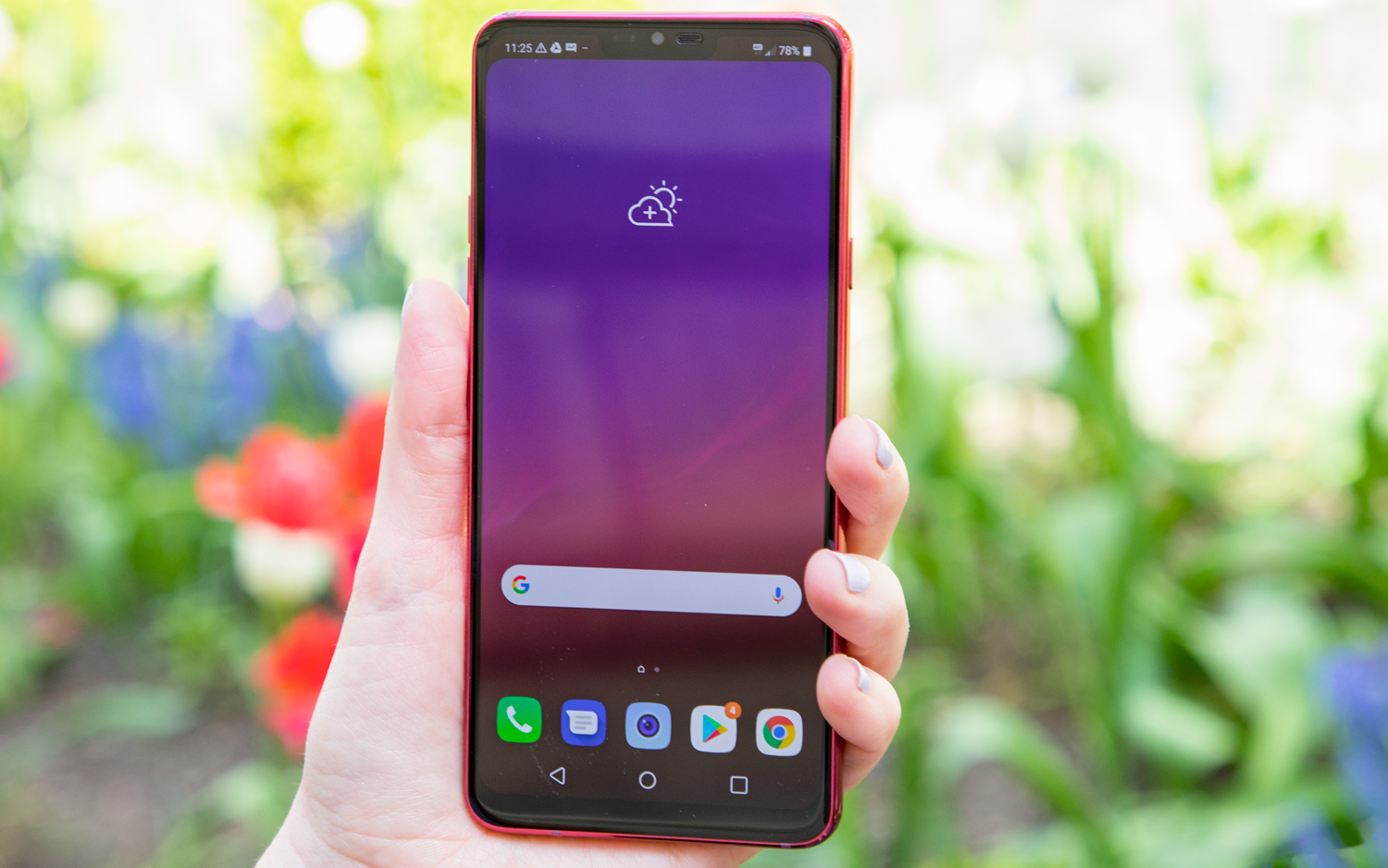
But a great camera and helpful voice-activated assistant are just table stakes for premium smartphones in 2018. LG could have differentiated the G7 with a fresh design, but instead the company made an Android version of Apple’s iPhone X, complete with a notch (though one you can disguise with a software bezel, suggesting that LG isn’t committed to it). The G7 ThinQ is a solid phone, but it isn’t the boundary-pushing stand-out that the company needs to compete with Apple and Samsung.
Update, June 1
We've updated this review now that the LG G7 ThinQ is on sale, with pricing information.
Price and Availability
In the U.S., the G7 ThinQ will only be available to order through a carrier. Sprint, Verizon and T-Mobile now sell LG’s latest flagship, with the phone costing $750 at T-Mobile and Verizon and $792 at Sprint. Project Fi, Google's wireless service, plans to offer the phone, too, though it's still listed as coming soon at that site. You can also get the G7 at US Cellular if you live within that regional carrier's coverage area.
AT&T is forgoing the G7 in favor of the more expensive LG V35 ThinQ, which has the same camera features as the G7 but features an OLED screen instead. That phone goes on sale June 8.
This review is based on my time with a U.S. pre-production unit.
LG G7 ThinQ Specs
| Price | $750-$792 |
| Display (Resolution) | 6.1 inches (3120 x 1440) |
| Rear Camera | 16-MP (f/1.6) main lens and 16-MP (f/1.9) wide-angle lens |
| Front Camera | 8-MP (f/1.9) |
| CPU | Snapdragon 845 |
| RAM | 4GB |
| Storage | 64GB |
| microSD | Yes, up to 2TB |
| Battery | 3,000 mAh |
| Battery Life (Hrs:Mins) | 8:35 |
| Colors | Platinum Gray, Aurora Black, Moroccan Blue, Raspberry Rose |
| Size | 6.03 x 2.83 x 0.31 inches |
| Weight | 5.71 ounces |
Display: Solid, but not OLED
A smartphone with an edge-to-edge display that sports a cut-out for the front-facing camera and handset earpiece — otherwise known as a notch — isn’t exactly cutting-edge anymore. Apple Essential and Huawei all have flagships with cut-outs at the top of their expansive displays; Asus will soon join them. The OnePlus 6, set to be unveiled later this month, is rumored to feature a notch, too. So when LG took the wraps off the G7 ThinQ, complete with a notch, we weren’t surprised. At this point, Samsung is the lone hold-out.
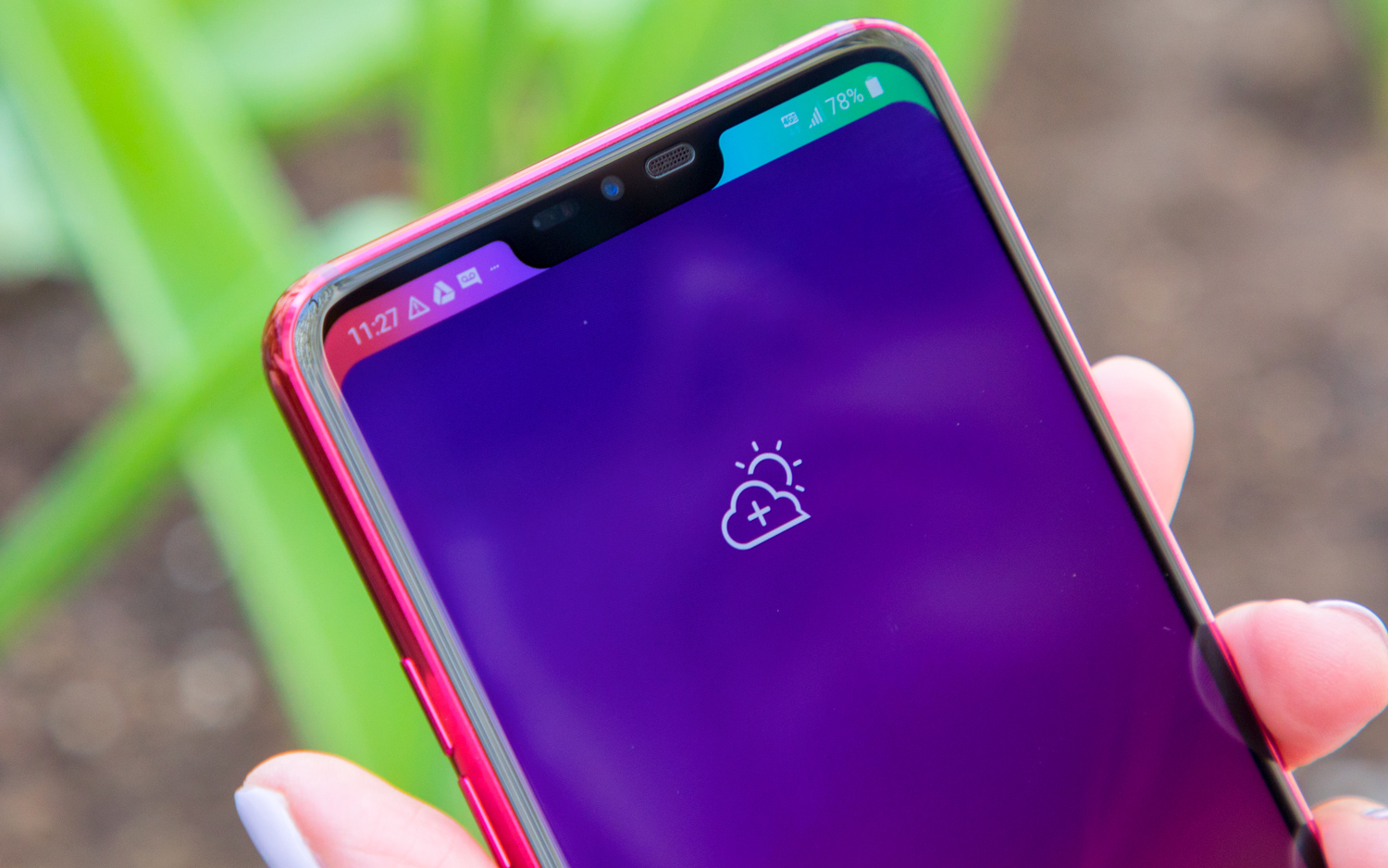
The G7’s 6.1-inch, 3120 x 1440 display has a larger than standard 19.5:9 aspect ratio, which makes it wider than the 18:9 screen on last year’s LG G6. The new phone’s notch is easily disguised with a software-based bezel under Settings > Display > New Second Screen. There are five bezel colors to choose from, including a rainbow gradient. But when you select black to disguise the notch altogether, the cut-out is still visible if you look closely. That’s because brightly lit LCD panels can’t match the true black and richer colors of an OLED display.
MORE: These Smartphones Can Replace a Compact Camera
It’s also unclear why LG calls the software bezel a “new second screen,” similar to a feature available on the LG V20 a few years ago, because it’s not really a second screen. It’s just where your icons live. You still have to swipe down to view notifications.
The G7’s display covers 138.8 percent of the sRGB color gamut, compared to the 231 percent covered by the Galaxy S9’s OLED panel. Samsung’s panels are impressive. To compare, Huawei’s $799 Mate 10 Pro also has an OLED display, but its color range and accuracy are in line with the G7’s. The Mate 10 Pro covers 147.2 percent of the color gamut and scored 0.62 on the Delta-E color accuracy test (numbers closer to zero are better). The G7 notched a 0.37 Delta-E score.
The G7’s display was bright and clear when I streamed the latest Ant-Man and the Wasp Trailer on YouTube, but the Galaxy S9’s screen was easily the winner. Ant-Man’s crimson suit and the gleaming red of a smashed tomato popped through Samsung’s phone. The colors were less saturated on the G7’s display.
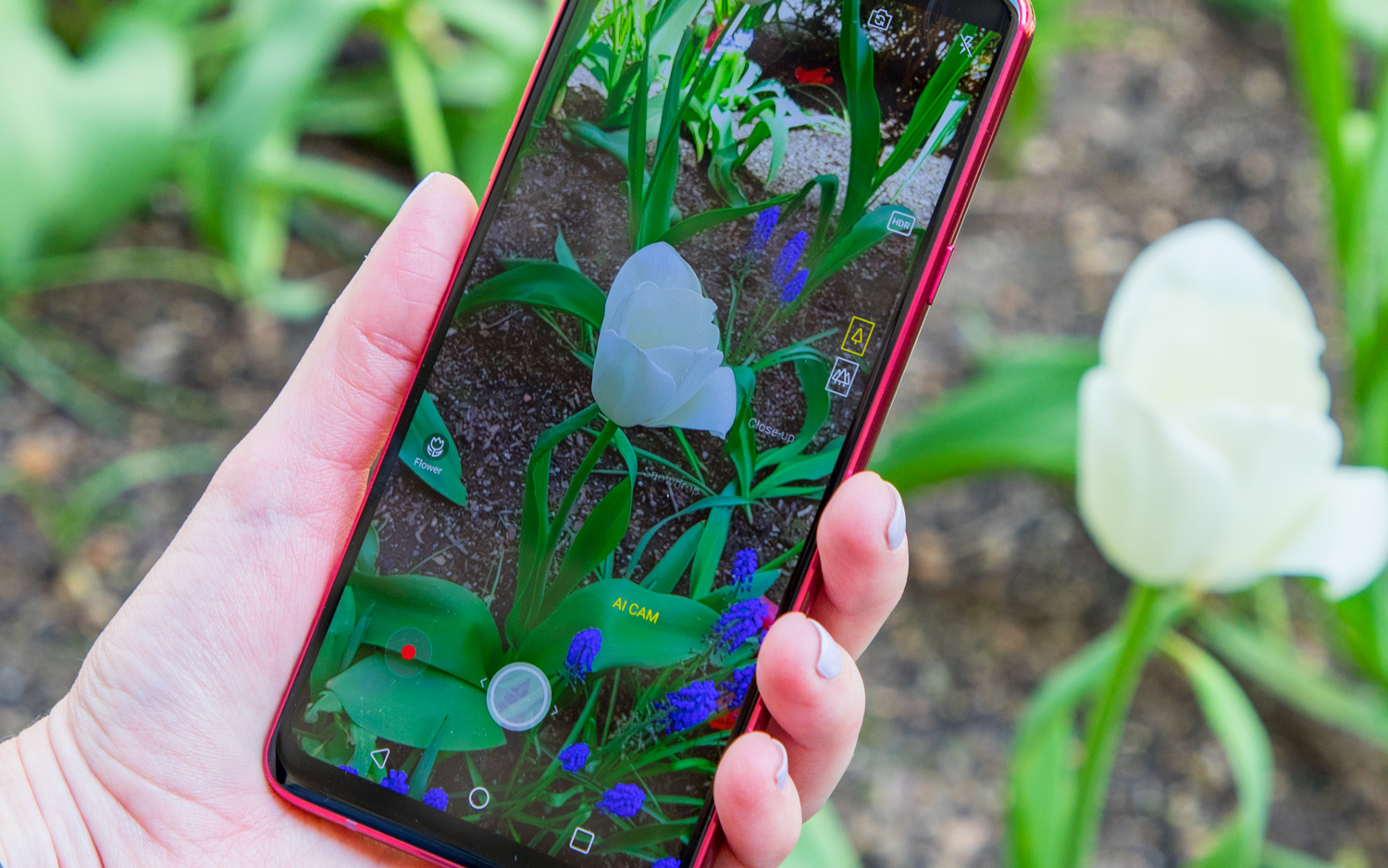
One of the G7’s selling points is its brightness. LG says its display can reach peak brightness of 1,000 nits, which means it should be easier to view in daylight. We simulated glaring sunlight in our indoor lab and used a light meter to determine how bright the LCD panel could get. The G7 cleared 900 nits with brightness turned to 100 percent, which is the highest peak we’ve seen in any smartphone we’ve tested.
The G7 ThinQ looks like the iPhone X and Galaxy S9 had a baby.
But that doesn’t mean much in real-world scenarios. I used the G7 outside many times over the course of my time reviewing the device, usually with brightness turned up all the way, and the display didn’t seem any brighter than other phones I’ve used. When we shot the G7 on a slightly overcast day in the Brooklyn Botanic Garden, our photographer couldn’t see any detail on the screen at all through his DSLR lens, so we had to move to a shaded location.
Design: Playing it safe
The G7 ThinQ looks like the iPhone X and Galaxy S9 had a baby. The device, which is a little over six inches tall, is covered with Gorilla Glass 5. Like last year’s G6, the G7 supports wireless charging. And LG is keeping the headphone jack around on this phone. A new button located a safe distance from the volume rocker on the side of the device calls up Google Assistant. (More on that later.)
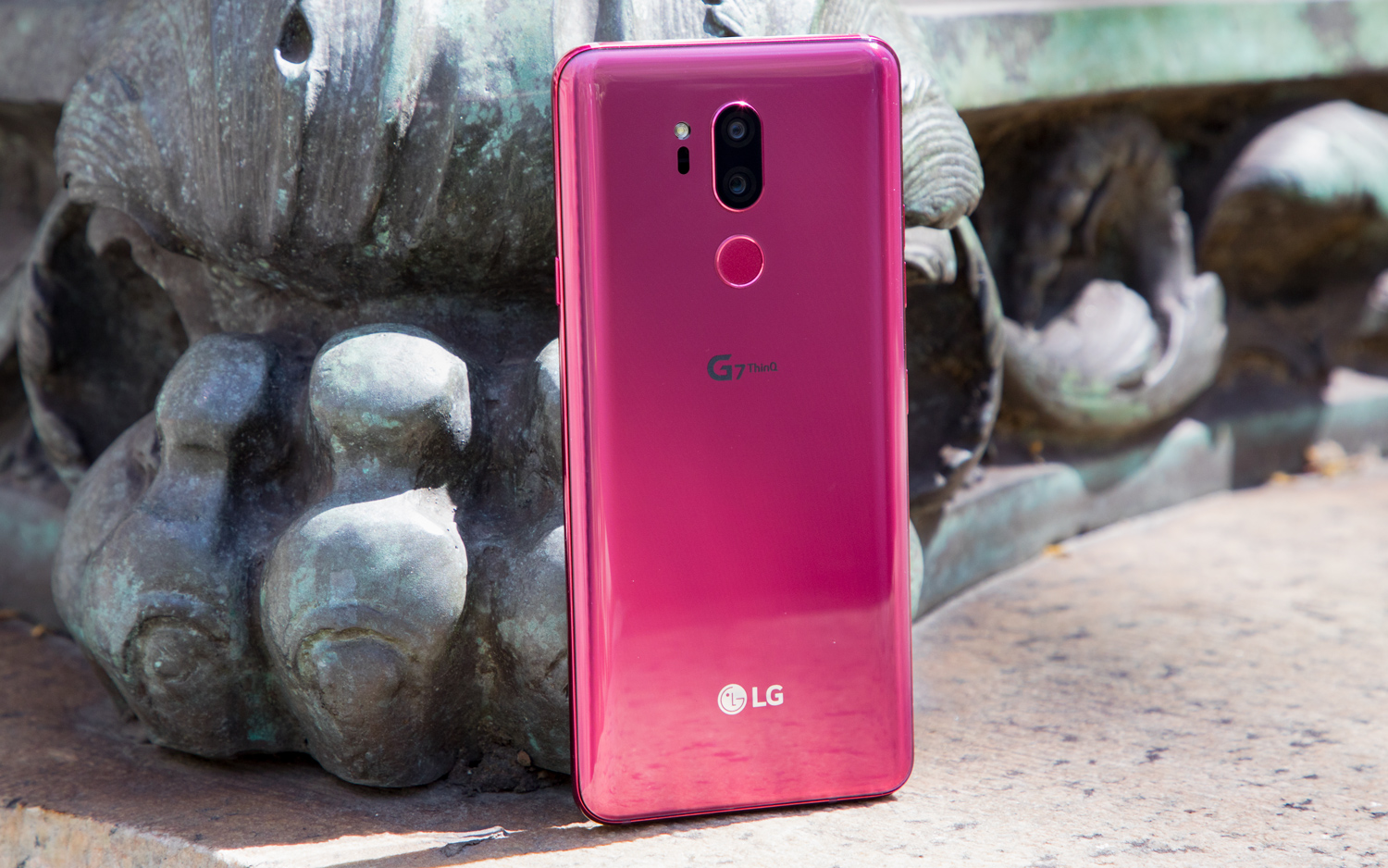
Overall, the G7 is a nice-looking phone. LG offers four shades: Platinum Gray, Aurora Black, Moroccan Blue and Raspberry Rose, which is the version I tested for this review. The phone feels comfortable to hold, though not exactly easy to use one-handed. It’s also incredibly lightweight at 5.71 ounces, making it more svelte than the G6 but not quite as light as LG’s own V30.
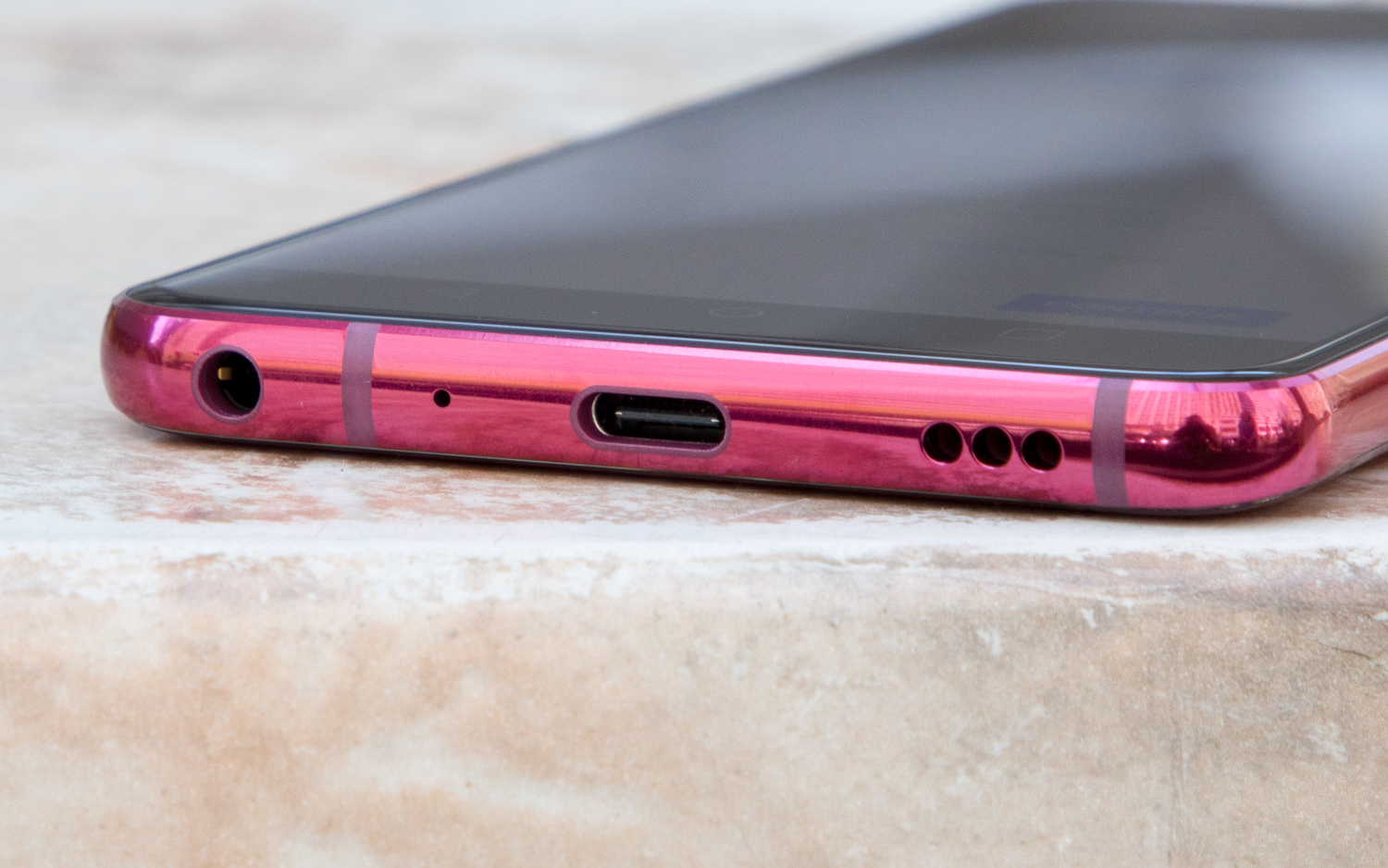
But LG is playing it safe with this phone. The company was a trendsetter when it introduced the G6, which was part of the first wave of smartphones to feature an edge-to-edge display with super-thin bezels and an ultra-wide 18:9 aspect ratio. Now it feels like the company is trying to catch up to Apple and Samsung. The notch, the assistant button, the high-shine, jewel-toned finishes — LG isn’t breaking any molds. It’s not even trying.
Camera: AI ups the ante
One of the G7’s standout features is its 16-megapixel dual-lens camera. LG has been putting a standard lens and a secondary wide-angle lens in its cameras for a few generations now, but the G7’s camera system is a lot smarter.
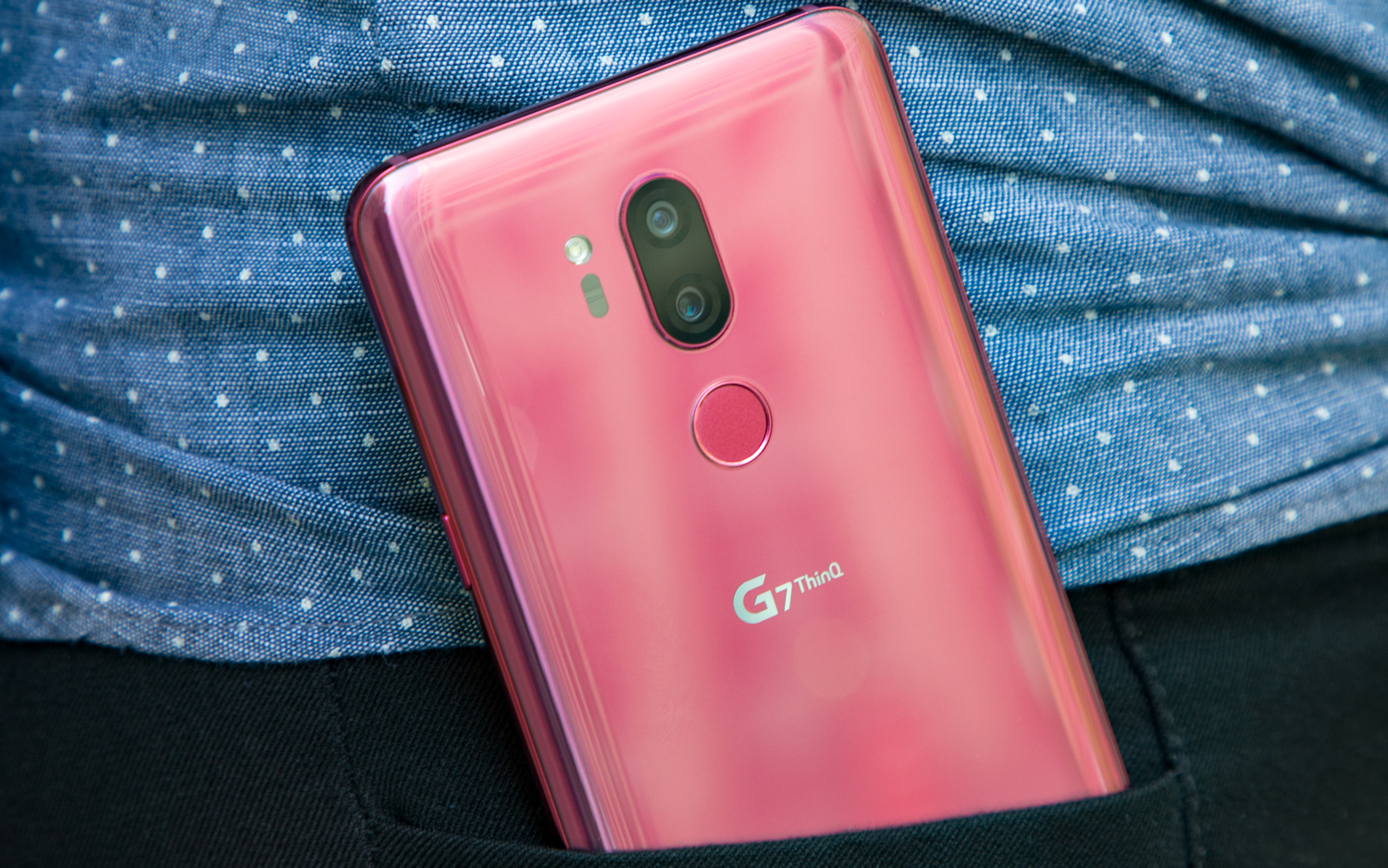
Like the V30 and V30S ThinQ he device uses EyeEm’s image recognition technology to identify 1,162 objects and categorize them in 18 scenes, such as food, flowers and landscape. In AI mode, which you can turn off, the camera automatically optimizes its settings depending on what you’re shooting. Once it locks onto the scene, the phone vibrates lightly to give you the go-ahead to start shooting. An icon denoting the scene, such as a fork and knife for food or a snowflake for snow, appears on the lower left of the live preview so you know that the camera settings are tuned to the correct category.
AI gives LG’s camera a leg up on the competition.
The image recognition, which happens almost instantly, is almost always spot-on. Occasionally the camera will misidentify a scene, like when I was shooting a bed of tulips and a snowflake icon appeared on-screen, but it corrects itself within a few seconds if you aim the camera elsewhere and then point it back toward the scene you want to capture.
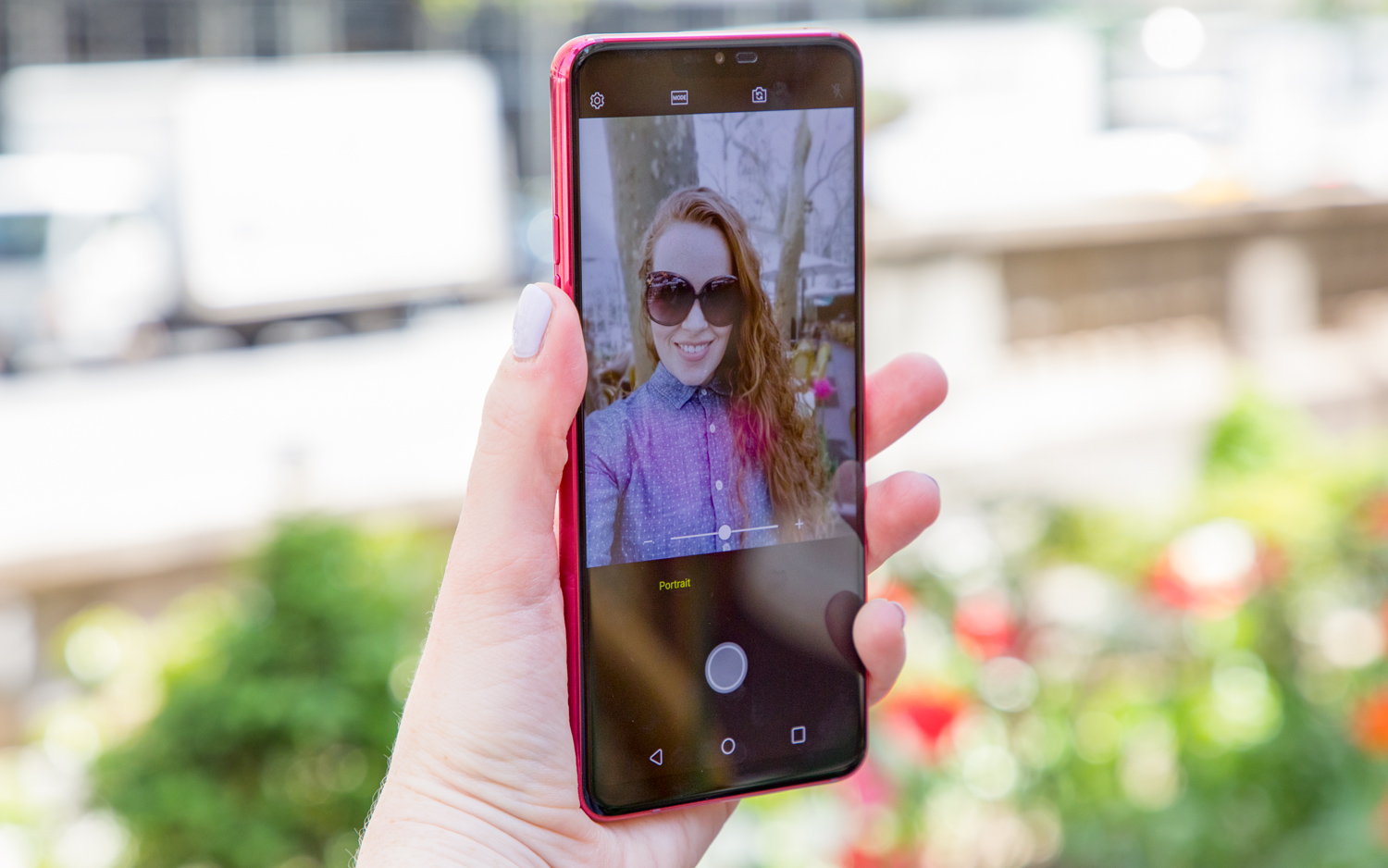
AI gives LG’s camera a leg up on the competition. I captured tulips in full bloom at the Brooklyn Botanic Gardens on both the G7 and dual-lens shooter on Samsung’s Galaxy S9+. With AI assistance, the G7 captured the saturated shades of marigold, lilac, peach and pink tulips contrasted with the green of the flower stems and grass. The S9+ capably captured the flower beds, but its images were less vivid and the color contrasts were less stark compared to the G7.
But the G7’s camera failed to impress when I attempted to shoot the Chrysler Building from a few blocks away. The camera captured the richly hued purple flowers at the edge of the frame, but details in the slightly overcast sky and in the Chrysler Building’s windows were missing. The Mate 10 Pro’s camera, which also offers image recognition features, more accurately captured the scene’s contrasts, such as the white cloud wisps against the blue sky. The Chrysler Building appears more starkly against the blue backdrop. The Galaxy S9+ also captured the sky more accurately than the G7, but the Mate 10 Pro took the best shot here.
When it comes to food photography, the G7 wins. Its camera, which automatically optimized its settings for food, highlighted the contrasts of golden doughnut, white sugar and deep brown chocolate drizzle. The same plate of mini doughnuts appeared dull in the images captured by the S9+ and the Mate 10 Pro.
The G7 also shines in low-light scenarios. LG uses pixel binning, which combines four nearby pixels into one superpixel to quadruple light sensitivity, to deliver brighter photos without flash. This happens automatically, but the device alerts you when it activates low-light mode and you can turn it off by tapping the low-light icon on-screen. The processing takes several seconds, comparable to taking a photo with flash, but at least you’re not blinding anyone.
I found the G7’s low-light mode delivered better shots of objects than of people. The dimmer the environment, the lower the resolution, so while the image is bright, it’s also full of noise. Photos of friends in an extremely dark bar made it seem like they were having drinks a brightly lit room, but the image quality looked like I had used my 2006-era flip phone to shoot them. Photos of beers in a dimly lit outdoor bar were much less noisy.
The G7 is unusual in that the secondary lens in its dual-lens set-up is a wide-angle lens rather than a telephoto one, but the device is still capable of shooting portraits where the subject of the photo is brought into focus and the background is blurred. A sliding tool on the the live preview lets you adjust the strength of the portrait effect, and you can also edit the image after shooting.
I found the live preview didn’t accurately show what the final portrait would look like — the resulting photo was always better than the preview indicated, which is good, but I wish the preview was more true-to-life.

The 8-megapixel front-facing camera is also capable of shooting portraits. Like the rear camera, the G7’s selfie cam’s portrait effect can be adjusted in post. The front-facing portraits are best for solo selfies. For duos or groups, you have to position everyone so you’re all on the same plane; otherwise one person will be blurred into the background.
Audio: Powerful Boombox Speaker, but surround sound is better
The G7’s audio prowess is a highlight that sets the phone apart. LG turned the inside of the G7 into a resonance chamber, which makes the device a powerful speaker when you pump the volume up.
“That’s probably enough to annoy an entire subway car,” my husband said as I blasted Justin Timberlake’s thumping “Damn Girl.”
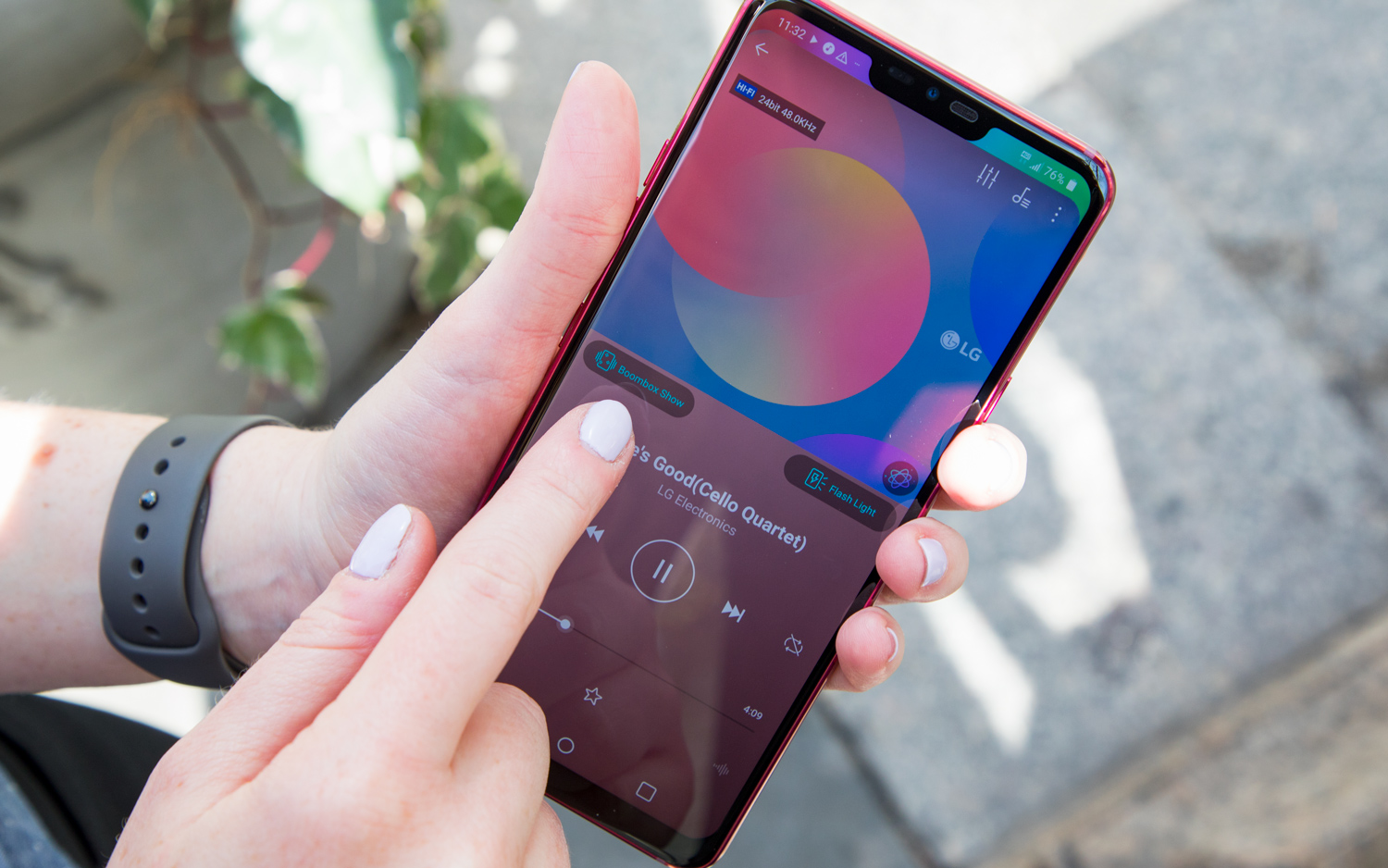
The G7 is noticeably louder than other smartphones, as I learned when I played the same song on the stereo speakers my iPhone 7 Plus to compare. The G7’s sound was definitely booming. But it’s still just a smartphone speaker. If you want to blast tunes as you clean your house or need a speaker to provide the soundtrack to your next party, you’ll need something more powerful, like a Bluetooth speaker.
The G7’s Boombox speaker is a fun bonus when playing car-racing games, because the vibrations make the device feel like a steering wheel thrumming with the power of a souped-up engine.
The G7’s built-in DTS-X 3D surround sound is the audio feature I really need. When you plug in a pair of wired headphones and activate the surround sound option in the Settings app (under Sound quality and effects), music sounds like it’s playing all around you. You can choose to listen to tracks balanced in front, from side to side or wide. I prefer wide. This feature makes each layer of a song sound distinct, even on a pair of cheap headphones. It’s awesome.
The phone also supports Hi-Fi Quad DAC for experts with lossless audio files or who subscribe to Tidal’s Hi-Fi tier.
Performance: Powerful and reliable
LG released last year’s G6 with a processor that was quickly outmatched by a newer Snapdragon chip (835, at the time). The company didn’t make the same mistake twice.
With Qualcomm’s latest Snapdragon 845 chip and 4GB of RAM, we expected the G7 to match the Galaxy S9, powered by the same processor and the same amount of RAM. The G7 is up there with the top-performing flagships in our benchmarking tests.
On the Geekbench 4 test of overall system performance, the G7 hit 8,566 — higher than both the Galaxy S9 (7,276) and the S9+, which has 6GB of RAM but clocked 8,295. The Mate 10 Pro (with a Kirin 970 processor) and Snapdragon 835-powered V30 are nowhere near as powerful, notching scores of 6,784 and 6,131, respectively.
MORE: Best Smartphones on the Market Now
With a dozen other apps open, I sailed my Subaru off ramps and easily cleared the tops of police cars in the graphically intensive Need for Speed: No Limits. Each race loaded quickly and my car responded instantly as I pressed a thumb to the screen to steer left or right. The G7’s Boombox speaker is a fun bonus when playing car-racing games, because the vibrations make the device feel like a steering wheel thrumming with the power of a souped-up engine. It’s an easy way to get a hit of adrenaline on a relaxing weekend afternoon.
On 3DMark’s Sling Shot Extreme OpenGL ES 3.1, a demanding test of graphics performance, the G7 scored 4,201. The Galaxy S9 and S9+ were higher-performing with scores of 4,617 and 4,634, respectively.
We also tested the G7’s performance using a real-world scenario, exporting a 2-minute 4K video file. The device took just 3 minutes and 16 seconds to handle that task. The Galaxy S9 was slower at 3:29 while the S9+, with its extra RAM, was faster at 2:32.
Software: Google Assistant shines
Instead of creating its own voice-activated assistant to compete with Siri, Alexa or Bixby, LG went all-in with Google’s own Assistant. This was a good move. Beneath the G7’s volume rocker on its left edge is a dedicated button to summon the assistant without having to say “Hey Google.”
Google Assistant is just as useful on the G7 as it is on other devices, such as the Pixel 2. The assistant can play music for you, give you the weather forecast, set reminders and timers, among other useful tasks. Google and LG teamed up on 32 commands specific to the G7, many of them camera-focused. You can ask Assistant to launch the AI Cam, or to take a photo in portrait mode. If you ask Assistant to take a photo, be ready to shoot — the camera gives you just three seconds before it clicks the shutter.
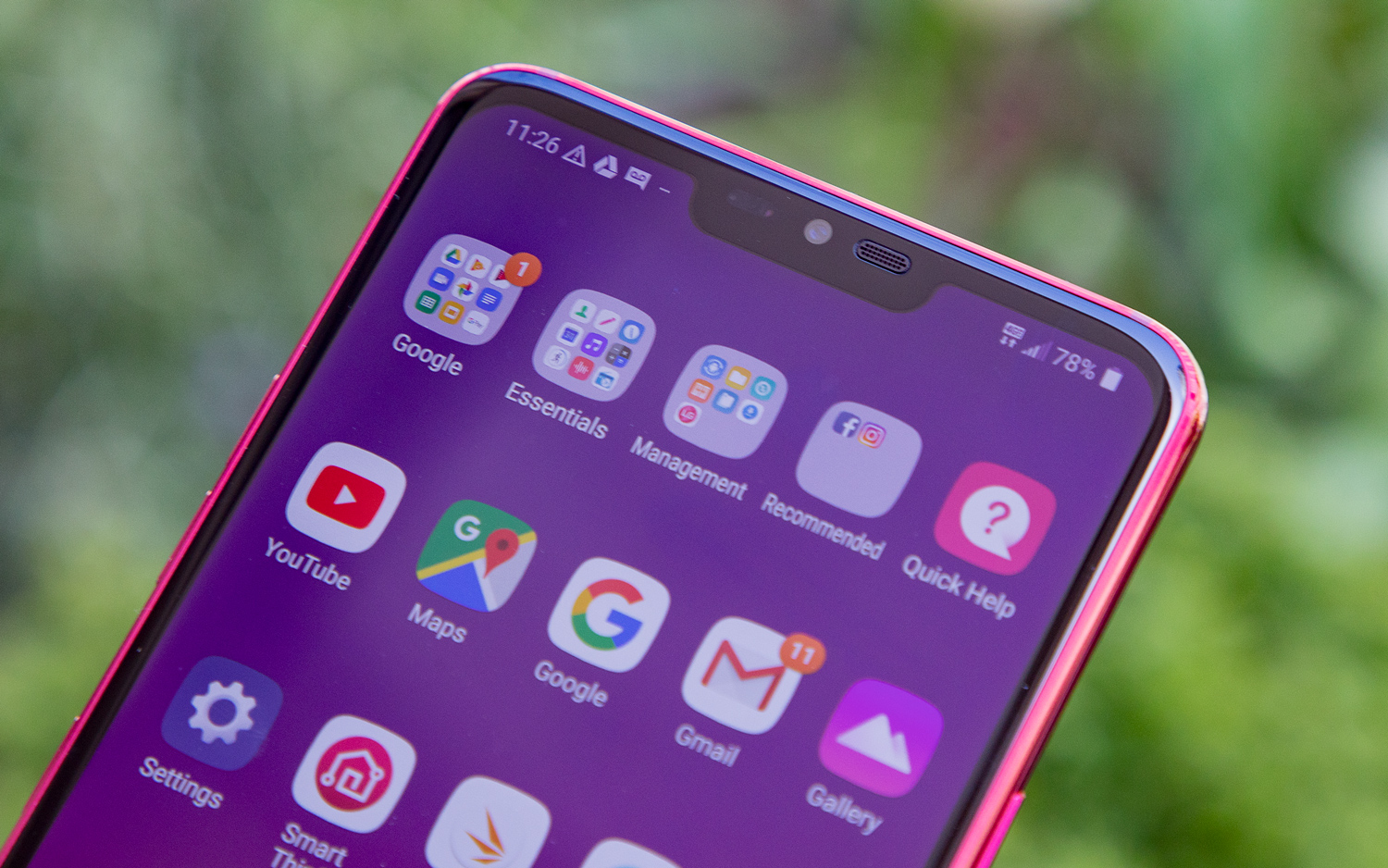
I’m not sure the G7 really needs an Assistant-dedicated button, especially one that can’t be reprogrammed for other tasks (though LG says that may be possible in a future software update should enough people demand it), given that there are two other ways to summon Google Assistant. Saying “Hey Google” still works, and so does a long press on the home button. Pressing a physical button is no more convenient than those options.
The G7 is shipping with Android 8.0 Oreo; LG says it will be upgradeable to Android P, rolling out later this year.
Battery Life: Needs improvement
LG’s flagship smartphones consistently fall short when it comes to battery life, and the G7 ThinQ is no exception. The phone’s 3,000 mAh battery should fall in line with the smartphone average of 9 hours and 50 minutes. In the Tom’s Guide Battery Test, continuous web-surfing over T-Mobile’s 4G LTE network, the G7 lasted 8 hours and 35 minutes.
MORE: Smartphones with the Longest Battery Life
Rival flagships such as the Galaxy S9, Mate 10 Pro and iPhone X all last hours longer than the G7 in our testing. The Mate 10 Pro still reigns supreme with its impressive 14:33 battery life.
LG’s flagship smartphones consistently fall short when it comes to battery life, and the G7 ThinQ is no exception.
The G6 suffered from the same critical issue, lasting 8 hours and 39 minutes in our testing. The V30 turned in an even more pitiful performance, lasting just 6 hours and 30 minutes. LG includes a fast-charging cable in the box, which quickly juices the G7 back up to 100 percent, but a smartphone released in 2018 should have a long-lasting battery and support quick-charging, not force you to choose one or the other.
Bottom Line
LG must be frustrated. Past attempts at innovation, the modular G5 and the G6, which pushed smartphone cameras and displays forward, haven’t toppled Samsung. Meanwhile, Huawei’s camera technology and OnePlus’s vivid displays and affordable price are making those companies more competitive. So LG scaled back its ambitions with the G7, a flagship phone that follows in the footsteps of the company’s rivals.
That’s not to say the G7 is a bad phone. But by taking the features that have made other flagships stand out and bundling them in one tidy package, LG isn’t doing anything to differentiate itself. The G7 is a fine phone. But it’s not a must-buy.
Credit: Shaun Lucas/Tom's Guide
Caitlin is a Senior editor for Gizmodo. She has also worked on Tom's Guide, Macworld, PCWorld and the Las Vegas Review-Journal. When she's not testing out the latest devices, you can find her running around the streets of Los Angeles, putting in morning miles or searching for the best tacos.
-
nickebrenner So, the first half of the article poops all over the phone, while the embedded video praises it, and the second half sounds great. First half was like it's just a copy of it's competitors, then here's all these great things about it, then, it's like they didn't even try. Not sure that's how a balanced review is supposed to work.Reply
And I know everyone has their own opinions, but a dedicated Google Assistant button vs the dedicated Bixby button on my wife's Galaxy, seems way more useful. We have found no use for Bixby. Yet the article only states how pointless this button seems. -
boridalli070 bad review ,this is pre production model i n test ,In everything you find the fault, nothing is wrong to you.Reply -
integrazimmy.facebook I don't understand how Tom's Hardware arrives at those crazy battery life numbers. If you view many videos on YouTube on battery drain comparison tests, the king and undisputed Champion is the LG V30. And at least on those videos, you can see the battery test in action. Here, we have to take their word for it. And yes, this is a Pre Production unit. Isn't there like an embargo on full reviews until you get the retail unit? So many things wrong with this review. Smh!Reply
